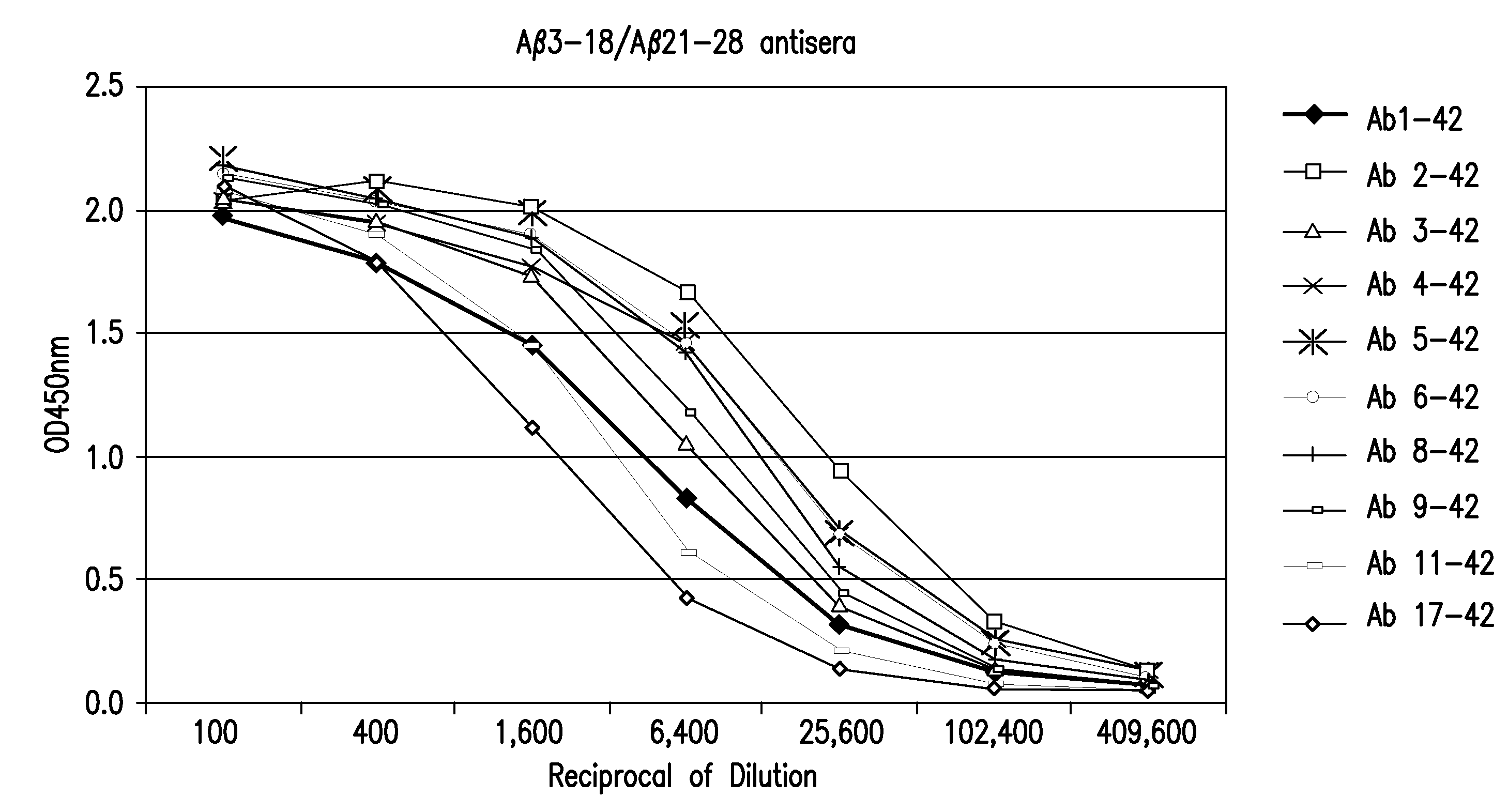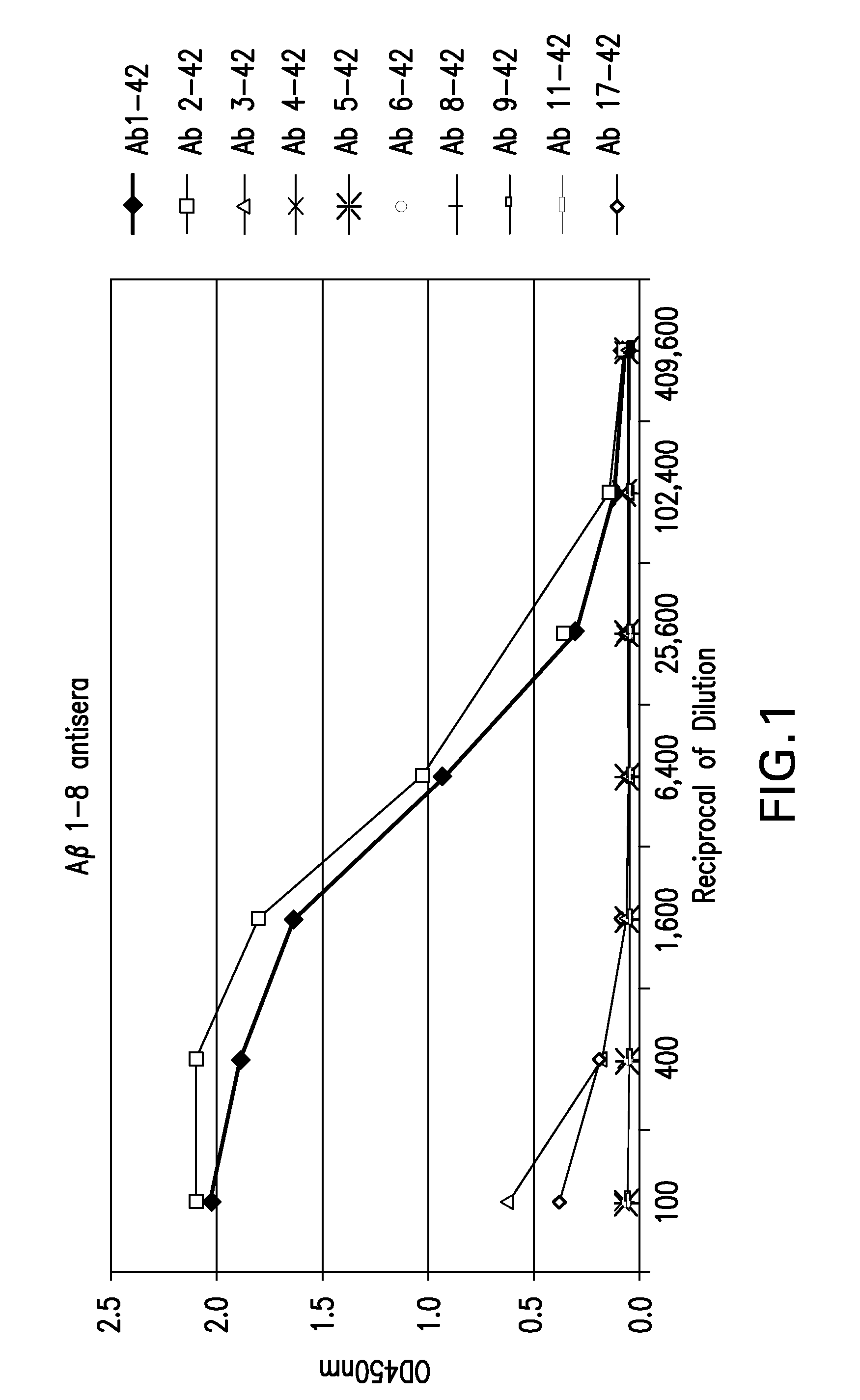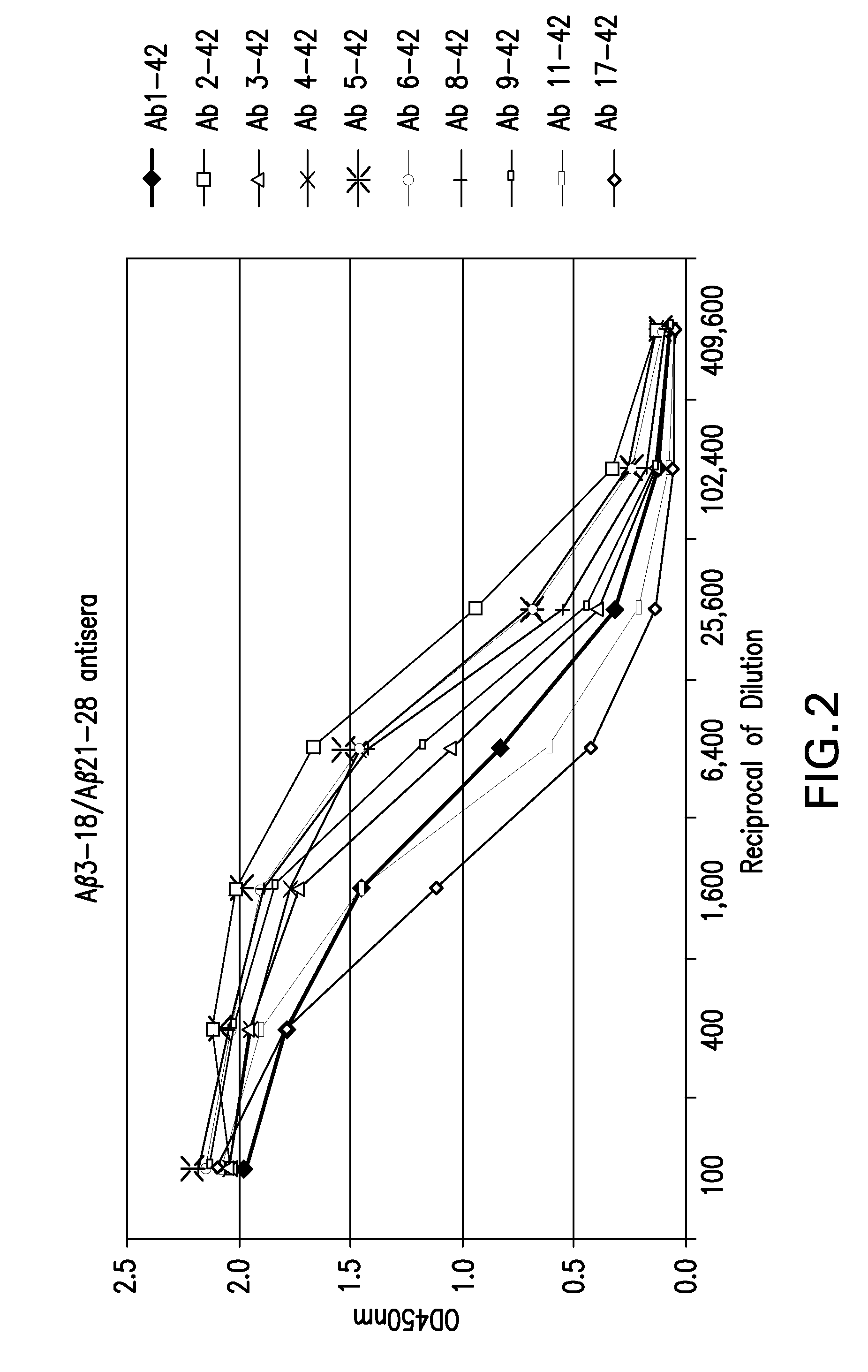Vaccine for the treatment of alzheimer's disease
- Summary
- Abstract
- Description
- Claims
- Application Information
AI Technical Summary
Benefits of technology
Problems solved by technology
Method used
Image
Examples
example 1
A. Preparation of Peptides and Immunogens
[0043]The peptides used herein were, with the exception of Aβ42, were purchased from Anaspec, San Jose, Calif. A listing of these peptides is given in Table 2. Aβ42 was prepared as shown in Example 1.B.
TABLE 2β-Amyloid(1-42)Example 1.BDAEFRHDSGYEVHHQKLVFFAEDVGSNKGAIIGLMVGGVVIA(SEQ ID NO: 3)β-Amyloid(2-42)Anaspec, San Jose, CAAEFRHDSGYEVHHQKLVFFAEDVGSNKGACat # 29909-01IIGLMVGGVVIA(SEQ ID NO: 4)[pGlu]-β-Amyloid(3-42)PyrE-FRHDSGYEVHHQKLVFFAEDVGSNAnaspec, San Jose, CAKGAIIGLMVGGVVIACat # 29907-01(SEQ ID NO: 5)β-Amyloid(4-42)FRHDSGYEVHHQKLVFFAEDVGSNKGAIIAnaspec, San Jose, CAGLMVGGVVIACat # 29908-01(SEQ ID NO: 6)β-Amyloid(5-42)RHDSGYEVHHQKLVFFAEDVGSNKGAIIGAnaspec, San Jose, CALMVGGVVIACat # 60087-01(SEQ ID NO: 7)β-Amyloid(6-42)HDSGYEVHHQKLVFFAEDVGSNKGAIIGLAnaspec, San Jose, CAMVGGVVIACat # 60086-01(SEQ ID NO: 8)β-Amyloid(8-42)SGYEVHHQKLVFFAEDVGSNKGAIIGLMVAnaspec, San Jose, CAGGVVIACat # 60085-01(SEQ ID NO: 9)β-Amyloid(9-42)GYEVHHQKLVFFAEDVGSNKGAIIG...
example 2
Generation of Guinea Pig Anti-Aβ Peptide Sera
[0048]Six to ten week-old female guinea pigs were obtained from Charles River, Inc., Raleigh, N.C. and maintained in the animal facilities of Merck Research Laboratories in accordance with institutional guidelines. All animal experiments were approved by Merck Research Laboratories Institutional Animal Care and Use Committee (IACUC). Aβ peptide conjugates, Aβ1-8 (MoVCAβ1-8)-KLH and Aβ (3-10)(21-28) (MVC)-OMPC, were formulated with 100 μg / ml of ISCOMATRIX® (CSL, Ltd., Parkville, Australia) and 100 μg / ml of ISCOMATRIX® plus 450 μg / ml of Merck aluminum alum, respectively. The final antigen concentrations, based on the peptide content, were 8 μg / ml and 4 μg / ml for Aβ1-8-KLH and Aβ (3-10)(21-28)-OMPC, respectively. Two guinea pigs were immunized with 400 μl of each conjugate intramuscularly twice at four week intervals and blood samples were collected between three and four weeks following the second immunization. Serum samples from each group...
example 3
Binding of Guinea Pig Antisera to Various Forms of Various Forms of Aβ Peptides.
[0049]Binding activity of guinea pig antisera to the Aβ peptides, full length and N-terminal truncated, were carried out by enzyme-linked immunosorbent assay (ELISA). Ninety-six well plates (Immuno 96 MicroWell™ Plate, ThermoFisher Scientific, Rochester, N.Y.) were coated with 50 μl per well of various Aβ peptides as shown in Table 2 at a concentration of 4 μg per ml in PBS at 4° C. over night. Plates were washed six times with PBS containing 0.05% Tween-20 (PBST) and blocked with 3% skim milk in PBST (milk-PBST). Guinea pig antiserum was prepared in milk-PBST at serial 4-fold dilutions. One hundred μl diluted anti-sera were added to each well and the plates were incubated for two hours at room temperature, followed by three washes with PBST. Fifty μl of HRP-conjugated goat anti-guinea pig secondary (Jackson Immuno Research, West Grove, Pa.) at a 1:5000 dilution in milk-PBST was added per well and then i...
PUM
| Property | Measurement | Unit |
|---|---|---|
| Time | aaaaa | aaaaa |
| Immunogenicity | aaaaa | aaaaa |
Abstract
Description
Claims
Application Information
 Login to View More
Login to View More - R&D
- Intellectual Property
- Life Sciences
- Materials
- Tech Scout
- Unparalleled Data Quality
- Higher Quality Content
- 60% Fewer Hallucinations
Browse by: Latest US Patents, China's latest patents, Technical Efficacy Thesaurus, Application Domain, Technology Topic, Popular Technical Reports.
© 2025 PatSnap. All rights reserved.Legal|Privacy policy|Modern Slavery Act Transparency Statement|Sitemap|About US| Contact US: help@patsnap.com



